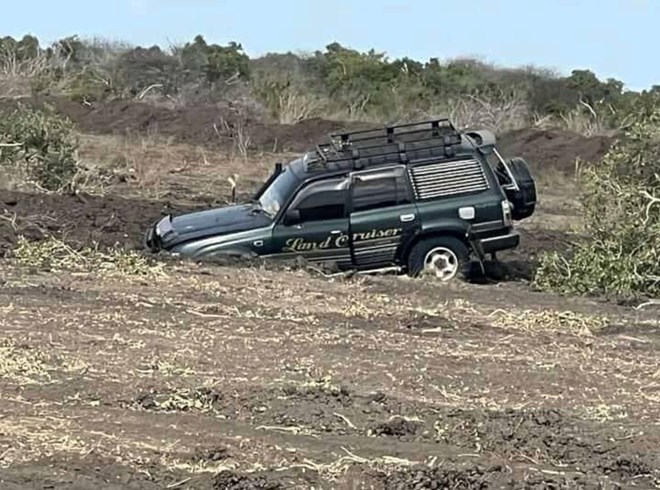
Thursday July 25, 2024
BY CALEB WEISS

One of Shabaab’s failed suicide car bombs that attacked the Somali National Army base at Miido, Lower Juba, as seen widely on social media.
In a coordinated, multi-pronged offensive, Shabaab, al Qaeda’s branch for East Africa, assaulted multiple Somali National Army (SNA) bases across southern Somalia’s Lower Juba region yesterday. Each side has claimed victory, with both releasing footage purporting to verify their claims.
Early yesterday, Shabaab mounted near-simultaneous attacks on SNA bases in the towns of Buulo-Xaji, Harbole, Miido, and Bar Sanguuni. All four locales surround the city of Kismayo, which sits within Somali government control, and the latter three towns are not far outside of the town of Afmadow.
Afmadow was under siege by Shabaab’s men until earlier this month when the SNA established greater control over this corridor by capturing Harbole and Miido. Yesterday’s assault was likely meant to recapture territory so that Shabaab could re-exert pressure on Afmadow and Kismayo.
The assault on the base at Buulo-Xaji began with at least one suicide car bombing, though it remains unclear if the other bases were also subjected to similar explosions. At least one failed suicide car bomb was filmed outside of the Miido base, however. The use of a suicide car bomb before a major attack on a military outpost is a common tactic used by the group.
At all locations, Shabaab’s men proceeded to assault the bases on foot using small arms and rocket-propelled grenades (RPGs). The attack on the Bar Sanguuni base was reportedly a diversionary measure to keep that base from reinforcing the others.
According to the Somali government, its soldiers, as well as its allies in the Jubaland Security Forces (JSF) and the Kenyan Defense Forces, repelled all of yesterday’s assaults, leaving behind a giant toll of dead Shabaab’s fighters. The Federal Government of Somalia in Mogadishu (FGS), for instance, announced that 80 Shabaab members were killed, while the JSF stated that over 135 fighters were killed. The Somali soldiers have also claimed to have taken dozens of Shabaab members as prisoners of war.
However, these numbers are hard to verify independently. Videos filmed by Somali security and subsequently posted on social media purport to show around 35 bodies of killed Shabaab members at one of the bases in Lower Juba. A few additional Shabaab fighters were shown to have been captured alive.
It is unclear if other bodies were not filmed or if Somali security forces have inflated the total number of Shabaab members killed yesterday, as it routinely engages in body count statistics to show it is winning against the al Qaeda branch.
Shabaab also claimed success, stating that its men instead overran each base, killing at least 71 soldiers. It also claimed to take dozens of Somali soldiers as prisoners of war. Much like the statements made by Somali security services, Shabaab’s claims are also difficult to verify independently.
A subsequent video released by the group earlier today purports to show its men briefly overrunning the Harbole base, killing several soldiers and capturing at least one, looting equipment, and driving off with several vehicles. However, Shabaab has thus far not shown any visual evidence to back up its claims of overrunning the other bases or inflicting particularly high casualties on Somali soldiers.
Given the media released by the Somali government, it is possible, if not likely, that Shabaab was indeed repelled at the other locations.
Yesterday’s coordinated assault highlights several key issues. First, though the Somali military just recently “captured” the same areas from Shabaab that were attacked yesterday, the security situation remains tenuous around Afmadow and Kismayo, showing the ebb-and-flow of this conflict.
Second, this still-perilous situation is only further highlighted by Shabaab’s ability to mount such a large fighting force over a large area—presumably hundreds of fighters, given the multi-pronged, coordinated assault—despite the Somali government claiming to have cleared these road axes.
Finally, the information space remains murky as both sides compete on the ground and in the propaganda sphere. This situation makes independent reporting crucial in understanding the fight against Shabaab, particularly as the FGS intends to launch more offensives in Somalia’s south.
It is also imperative that the Somalian government maintains accurate reporting to avoid giving Shabaab additional free propaganda, as it has done in the past. Reliable information will become more important as more African Union troops depart from Somalia and Somali forces become more reliant on themselves.